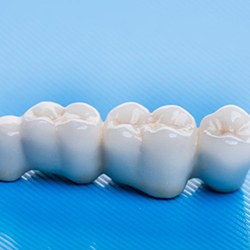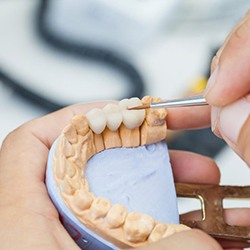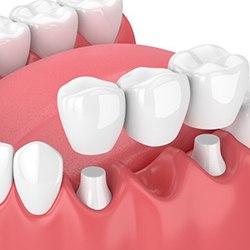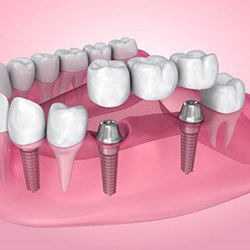Dental Bridges – Arlington, TX
Renew Your Smile’s Strength and Appearance

While human teeth are incredibly durable, they can be lost due to trauma or infection. Thankfully, dental bridges from I-20 Family Dental can replace one or several sequential missing teeth with lifelike and comfortable restorations that work like the real thing. Here’s a brief guide to how dental bridges work, but please don’t hesitate to contact Dr. Wardlaw’s staff if you have any questions.
Why Choose I-20 Family Dental for Dental Bridges?
- Compassionate and Experienced Dentist
- Restore Your Smile and Your Chewing Ability
- Flexible Financing Options Available
What is a Dental Bridge?

A dental bridge is a restorative appliance that consists of one or several artificial teeth suspended between two dental crowns or two dental implants. These versatile devices can replace one to four consecutive missing teeth, and almost anyone who has experienced tooth loss can get one as long as they are in good oral health otherwise. While the dental bridges of decades past were often made from strong metals such as gold or silver, bridges from I-20 Family Dental are made from lifelike materials so they blend in seamlessly with the rest of the smile.
Types of Dental Bridges

While each dental bridge is customized from the ground up to fit the individual patient, these appliances typically fall into one of two categories. After a brief consultation, Dr. Wardlaw will be able to determine which type is right for you.
Traditional Dental Bridge

Traditional dental bridges are one or several prosthetic teeth strung between two dental crowns supported by the healthy teeth on either side of the gap in the smile. These appliances can restore a patient’s chewing ability while also enhancing the appearance of their grin.
Implant Bridge

Implant bridges consist of a line of two or more artificial teeth supported by titanium posts surgically implanted in the jawbone. This allows these appliances to last much longer, provide superior chewing power, and maintain the health of the jaw without the alteration of any healthy remaining teeth.
The Benefits of Getting a Dental Bridge

Dental bridges offer a range of impressive benefits that can significantly improve a patient’s quality of life. A few of these include:
- Helping the remaining teeth stay in place so they don’t shift out of alignment.
- Improving a patient’s confidence by completing their smile and enhancing their speaking ability.
- Reinforcing chewing power so the patient can avoid overall health issues like malnutrition or indigestion.
- Protecting the gums from injury during the chewing process.
Only Dr. Wardslaw can make the definitive call as to whether a dental bridge can address your oral health needs. Scheduling a consultation at our Arlington office can set you on the path to achieving a beautiful, functional, and complete smile.
Dental Bridges FAQs
Can You Take a Dental Bridge Out?
No, dental bridges cannot come out without being removed by a dental professional. They were designed to stay in place in your mouth for many years.
Some dental professionals may refer to partial dentures as “removable dentures,” however, this is a misnomer, because while partial dentures are like bridges, they can be removed by the patient at any time while a dental bridge cannot.
Is Getting a Dental Bridge Painful?
The first step in your dental bridge procedure is for Dr. Wardlaw to numb the teeth he will be working on. This typically only requires a topical anesthetic, but if you are extremely nervous, I-20 Family Dental does offer sedation dentistry options.
After the preparation and placement of your dental bridge, your underlying teeth may feel sensitive for a few days. Most patients find that this can be easily managed with OTC pain relievers, but please call Dr. Wardlaw if the pain worsens.
Because dental bridges prevent your remaining teeth from shifting out of place, they could potentially prevent discomfort in the future. If you are getting an implant bridge, there will be some soreness after the surgery, but you will receive aftercare instructions that will help minimize pain during the healing process.
How Long Should a Dental Bridge Last?
On average, you can expect a dental bridge to last between five and fifteen years, but this will depend on a variety of factors, including the materials it’s made of. While metal bridges tend to last longer than tooth-colored materials, the difference is usually negligible, and most patients prefer tooth-colored bridges due to their discreet appearance.
More importantly than the materials, the longevity of your bridge greatly depends on individual factors like your diet, oral hygiene, and if you have any bad oral habits like smoking, grinding your teeth, nail biting, ice crunching, etc.
Bridges that replace front teeth may also last a little longer than those placed in back, as they are not subjected to as much wear and tear from chewing as the back teeth are.
If you have an implant-supported bridge, it will likely last longer than a traditional bridge. While you will still need to eventually replace the crowns, the implant posts are permanent and could remain in place for life with proper care.
Are Dental Bridges Covered by Insurance?
Yes, dental bridges are typically at least partially covered by dental insurance; however, the level of coverage depends on your individual provider and plan. Most plans consider bridges a major procedure and typically cover between 40 and 50 percent of the cost, but you will need to meet your deductible and cannot exceed your annual maximum.
At I-20 Family Dental, we also accept flexible financing through CareCredit, which can help make your treatment more affordable by breaking it into low-to-no interest monthly payments. You can learn more about this on our website or ask our friendly office team for more information.

